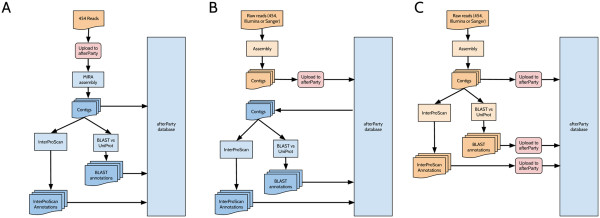Figure 2.

Flowcharts showing the three possible workflows offered by afterParty. Orange boxes represent data and processes external to the afterParty server. Blue boxes represent internal afterParty data and processes. Red boxes indicate steps where data are uploaded to afterParty. In workflow A, the user uploads raw 454 sequencing reads and both assembly and annotation are carried out inside afterparty. In workflow B, assembly is carried out externally. The user uploads a set of assembled contigs, and annotation is carried out inside afterParty. In workflow C, both assembly and annotation are carried out externally. The user uploads assembled contigs and their accompanying annotation. While workflow A is only suitable for Roche 454 sequencing data and relies on the MIRA assembler, workflows B and C can be applied to any type of sequencing chemistry or assembly protocol.
